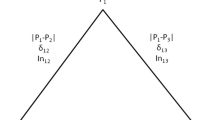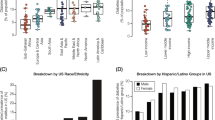Abstract
Admixture and population stratification are major concerns in genetic association studies. We wished to evaluate the impact of admixture using empirically derived data from genetic association studies of African Americans (AA) with type 2 diabetes (T2DM) and end-stage renal disease (ESRD). Seventy ancestry informative markers (AIMs) were genotyped in 577 AA with T2DM–ESRD, 596 AA controls, 44 Yoruba Nigerian (YRI) and 39 European American (EA) controls. Genotypic data and association results for eight T2DM candidate gene studies in our AA population were included. Ancestral estimates were calculated using FRAPPE, ADMIXMAP and STRUCTURE for all AA samples, using varying numbers of AIMs (25, 50, and 70). Ancestry estimates varied significantly across all three programs with the highest estimates obtained using STRUCTURE, followed by ADMIXMAP; while FRAPPE estimates were the lowest. FRAPPE estimates were similar using varying numbers of AIMs, while STRUCTURE estimates using 25 AIMs differed from estimates using 50 and 70 AIMs. Female T2DM-ESRD cases showed higher mean African proportions as compared to female controls, male cases, and male controls. Age showed a weak but significant correlation with individual ancestral estimates in AA cases (r 2 = 0.101; P = 0.019) and in the combined set (r 2 = 0.131; P = 3.57 × 10−5). The absolute difference between frequencies in parental populations, absolute δ, was correlated with admixture impact for dominant, additive, and recessive genotypic models of association. This study presents exploratory analyses of the impact of admixture on studies of AA with T2DM-ESRD and supports the use of ancestral proportions as a means of reducing confounding effects due to admixture.




Similar content being viewed by others
References
Brancati FL, Kao WH, Folsom AR, Watson RL, Szklo M (2000) Incident type 2 diabetes mellitus in African American and white adults: the atherosclerosis risk in communities study. JAMA 283:2253–2259
Buetow KH, Edmonson M, MacDonald R, Clifford R, Yip P, Kelley J, Little DP, Strausberg R, Koester H, Cantor CR, Braun A (2001) High-throughput development and characterization of a genomewide collection of gene-based single nucleotide polymorphism markers by chip-based matrix-assisted laser desorption/ionization time-of-flight mass spectrometry. Proc Natl Acad Sci USA 98:581–584
Elbein SC (2007) Evaluation of polymorphisms known to contribute to risk for diabetes in African and African–American populations. Curr Opin Clin Nutr Metab Care 10:415–419
Fernandez JR, Shiver MD (2004) Using genetic admixture to study the biology of obesity traits and to map genes in admixed populations. Nutr Rev 62:S69–S74
Fernandez JR, Shriver MD, Beasley TM, Rafla-Demetrious N, Parra E, Albu J, Nicklas B, Ryan AS, McKeigue PM, Hoggart CL, Weinsier RL, Allison DB (2003) Association of African genetic admixture with resting metabolic rate and obesity among women. Obes Res 11:904–911
Freedman BI, Yu H, Spray BJ, Rich SS, Rothschild CB, Bowden DW (1997) Genetic linkage analysis of growth factor loci and end-stage renal disease in African Americans. Kidney Int 51:819–825
Freedman BI, Volkova NV, Satko SG, Krisher J, Jurkovitz C, Soucie JM, McClellan WM (2005) Population-based screening for family history of end-stage renal disease among incident dialysis patients. Am J Nephrol 25:529–535
Goodman MJ, Chung CS (1975) Diabetes mellitus: discrimination between single locus and multifactorial models of inheritance. Clin Genet 8:66–74
Hawkes CH (1997) Twin studies in diabetes mellitus. Diabet Med 14:347–352
Lind JM, Hutcheson-Dilks HB, Williams SM, Moore JH, Essex M, Ruiz-Pesini E, Wallace DC, Tishkoff SA, O’Brien SJ, Smith MW (2007) Elevated male European and female African contributions to the genomes of African American individuals. Hum Genet 120:713–722
Long JC (1991) The genetic structure of admixed populations. Genetics 127:417–428
Kaiser Family Foundation (2007) State Health Facts Online. http://www.statehealthfacts.org/
Keene KL, Mychaleckyj JC, Smith SG, Leak TS, Perlegas PS, Langefeld CD, Freedman BI, Rich SS, Bowden DW, Sale MM (2008a) Association of the distal region of the ectonucleotide pyrophosphatase/phosphodiesterase 1 (ENPP1) gene with type 2 diabetes in an African American Population enriched for nephropathy. Diabetes 57(4):1057–1062
Keene KL, Mychaleckyj JC, Smith SG, Leak TS, Perlegas PS, Langefeld CD, Herrington DM, Freedman BI, Rich SS, Bowden DW, Sale MM (2008b) Comprehensive evaluation of the estrogen receptor alpha gene reveals further evidence for association with type 2 diabetes enriched for nephropathy in an African American population. Hum Genet 123(4):333–341
Louet JF, LeMay C, Mauvais-Jarvis F (2004) Antidiabetic actions of estrogen: insight from human and genetic mouse models. Curr Atheroscler Rep 6:180–185
Margolis KL, Bonds DE, Rodabough RJ, Tinker L, Phillips LS, Allen C, Bassford T, Burke G, Torrens J, Howard BV (2004) Effect of oestrogen plus progestin on the incidence of diabetes in postmenopausal women: results from the Women’s Health Initiative Hormone Trial. Diabetologia 47:1175–1187
McClellan W, Speckman R, McClure L, Howard V, Campbell RC, Cushman M, Audhya P, Howard G, Warnock DG (2007) Prevalence and characteristics of a family history of end-stage renal disease among adults in the United States population: reasons for geographic and racial differences in stroke (REGARDS) renal cohort study. J Am Soc Nephrol 18:1344–1352
McKeigue PM, Carpenter JR, Parra EJ, Shriver MD (2000) Estimation of admixture and detection of linkage in admixed populations by a Bayesian approach: application to African–American populations. Ann Hum Genet 64:171–186
McLean DC Jr, Spruill I, Argyropoulos G, Page GP, Shriver MD, Garvey WT (2005) Mitochondrial DNA (mtDNA) haplotypes reveal maternal population genetic affinities of Sea Island Gullah-speaking African Americans. Am J Phys Anthropol 127:427–438
Neel JV (1999) Diabetes mellitus: a “thrifty” genotype rendered detrimental by “progress”? 1962. Bull World Health Organ 77:694–703 Discussion 692–693
Parra EJ, Kittles RA, Argyropoulos G, Pfaff CL, Hiester K, Bonilla C, Sylvester N, Parrish-Gause D, Garvey WT, Jin L, McKeigue PM, Kamboh MI, Ferrell RE, Pollitzer WS, Shriver MD (2001) Ancestral proportions and admixture dynamics in geographically defined African Americans living in South Carolina. Am J Phys Anthropol 114:18–29
Pfaff CL, Barnholtz-Sloan J, Wagner JK, Long JC (2004) Information on ancestry from genetic markers. Genet Epidemiol 26:305–315
Pritchard JK, Stephens M, Donnelly P (2000) Inference of population structure using multilocus genotype data. Genetics 155(2):945–959
Reed FA, Tishkoff SA (2006) African human diversity, origins and migrations. Curr Opin Genet Dev 16:597–605
Reiner AP, Ziv E, Lind DL, Nievergelt CM, Schork NJ, Cummings SR, Phong A, Burchard EG, Harris TB, Psaty BM, Kwok PY (2005) Population structure, admixture, and aging-related phenotypes in African American adults: the Cardiovascular Health Study. Am J Hum Genet 76:463–477
Reiner AP, Carlson CS, Ziv E, Iribarren C, Jaquish CE, Nickerson DA (2007) Genetic ancestry, population sub-structure, and cardiovascular disease-related traits among African–American participants in the CARDIA Study. Hum Genet 121:565–575
Rotimi C, Cooper R, Cao G, Sundarum C, McGee D (1994) Familial aggregation of cardiovascular diseases in African–American pedigrees. Genet Epidemiol 11:397–407
Sale MM, Smith SG, Mychaleckyj JC, Keene KL, Langefeld CD, Leak TS, Hicks PJ, Bowden DW, Rich SS, Freedman BI (2007) Variants of the transcription factor 7-like 2 (TCF7L2) gene are associated with type 2 diabetes in an African-American population enriched for nephropathy. Diabetes 56(10):2638–2642
Seed M (2002) The choice of hormone replacement therapy or statin therapy in the treatment of hyperlipidemic postmenopausal women. Atheroscler Suppl 3:53–63
Shaffer JR, Kammerer CM, Reich D, McDonald G, Patterson N, Goodpaster B, Bauer DC, Li J, Newman AB, Cauley JA, Harris TB, Tylavsky F, Ferrell RE, Zmuda JM (2007) Genetic markers for ancestry are correlated with body composition traits in older African Americans. Osteoporos Int 18:733–741
Shriver MD, Parra EJ, Dios S, Bonilla C, Norton H, Jovel C, Pfaff C, Jones C, Massac A, Cameron N, Baron A, Jackson T, Argyropoulos G, Jin L, Hoggart CJ, McKeigue PM, Kittles RA (2003) Skin pigmentation, biogeographical ancestry and admixture mapping. Hum Genet 112:387–399
Smith MW, Patterson N, Lautenberger JA, Truelove AL, McDonald GJ, Waliszewska A, Kessing BD, Malasky MJ, Scafe C, Le E, De Jager PL, Mignault AA, Yi Z, De The G, Essex M, Sankale JL, Moore JH, Poku K, Phair JP, Goedert JJ, Vlahov D, Williams SM, Tishkoff SA, Winkler CA, De La Vega FM, Woodage T, Sninsky JJ, Hafler DA, Altshuler D, Gilbert DA, O’Brien SJ, Reich D (2004) A high-density admixture map for disease gene discovery in african americans. Am J Hum Genet 74:1001–1013
Tang H, Peng J, Wang P, Risch NJ (2005) Estimation of individual admixture: analytical and study design considerations. Genet Epidemiol 28:289–301
Tsai HJ, Choudhry S, Naqvi M, Rodriguez-Cintron W, Burchard EG, Ziv E (2005) Comparison of three methods to estimate genetic ancestry and control for stratification in genetic association studies among admixed populations. Hum Genet 118:424–433
Yu H, Bowden DW, Spray BJ, Rich SS, Freedman BI (1996) Linkage analysis between loci in the renin-angiotensin axis and end-stage renal disease in African Americans. J Am Soc Nephrol 7:2559–2564
Acknowledgments
We thank the individuals recruited as cases and controls for their participation, recruiters Joyce Byers and Mitzie Spainhour, technician Candace Gordon, programmer Matt Stiegert, and Mark Hansen and colleagues at Illumina Inc. This work was supported by grants DK066358, DK072550, DK070941, the Wake Forest University General Clinical Research Center M01 RR07122, and a Career Development Award from the American Diabetes Association (MMS).
Author information
Authors and Affiliations
Corresponding author
Additional information
An erratum to this article can be found at http://dx.doi.org/10.1007/s00439-008-0539-z
Electronic supplementary material
Below is the link to the electronic supplementary material.
Rights and permissions
About this article
Cite this article
Keene, K.L., Mychaleckyj, J.C., Leak, T.S. et al. Exploration of the utility of ancestry informative markers for genetic association studies of African Americans with type 2 diabetes and end stage renal disease. Hum Genet 124, 147–154 (2008). https://doi.org/10.1007/s00439-008-0532-6
Received:
Accepted:
Published:
Issue Date:
DOI: https://doi.org/10.1007/s00439-008-0532-6




